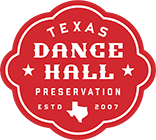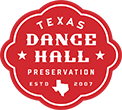by Jake Dromgoole
Recently, Texas Dance Hall Preservation advisory board member and Texas Polka News editor Gary E. McKee shared with me that some dance halls used to serve as skating rinks for their communities. This information came as a major surprise to me, though it probably should not have. In my time researching dance halls, and speaking to hall owners/operators, I have learned that Texas’ beloved dance halls have served a variety of functions from their beginnings. We may think of them as a toe-tapping, two-stepping, music venues, but they have always been so much more. But skating rinks? That’s a very innovative use of space. The following is a look at some of the other ways communities throughout Texas have used their dance halls.
Can you imagine watching professional wrestling in a dance hall? That’s what patrons did in December 1958, when they gathered to watch the champion (and future hall of famer) Johnny Valentine defend his title against Jesus Cardenas at the American Legion Hall in Columbus. That same year saw Frank’s Hall, located in New Ulm, host a “Game Party,” complete with 26 games starting at one dollar a piece. Various halls throughout Texas even had turkey shoots, where patrons would hunt for some prized poultry.
Of course, many of the state’s oldest and most treasured halls did not actually start as dance halls. Some were built as gathering places for German immigrants to learn and cultivate new skills after arriving in Texas. Societies dedicated to (among other activities) singing, gymnastics and agriculture began appearing in German communities. One example is Peters-Hacienda Community Hall in Austin County. Built in 1900 by legendary German architect Joachim Hintz, this eight-sided structure served as a meeting place for a Schuetzenverein, or shooting club, before becoming primarily used for dances. According to the Handbook of Texas History, shooting events would take place at these halls during the day, and dances would then occur in the evening.
Some halls, like the Cistern Hall located in Fayette County, even hosted plays and movies for their communities. According to a February 1940 clipping in The Flatonia Argus, the local C.Y.O. (Catholic Youth Organization) sponsored a play titled “Civil Service” at the hall, which was then followed by a dance with music from the Cistern Orchestra. Mr. McKee also informed me via email that thanks to its size, Cistern Hall even allowed itself to be used for showing movies as well.
Sometimes, other places of business were converted to host dances. The Clifton Skating Rink, located in Clifton, Texas (just outside of Waco). In 1933, the business welcomed legendary western swing bandleader Bob Wills and his Texas Playboys. Trying to capitalize on the popularity of roller-skating, the owners of Dismukes Hall (located in Edwards County) added a skating rink on the second floor of their hall. Some halls, like Bill’s Place in Weimar would even hold combination turkey shoot/roller-skating nights at their halls.
Though dance halls have played host to a variety of events and activities over the years, the thing they would eventually become most known for is of course, dancing. Today, halls welcome all types of guests, from local organizations meeting to discuss community business, to happy couples looking for the perfect place to celebrate their weddings and two-steppers, looking for a chance to immerse themselves in one of Texas’ oldest traditions. Though you might not see folks burning rubber on dance hall floors these days, you will almost certainly find groups of people gathering and sharing in common interests, just as they have done for decades.
Thank you to Mr. Gary E. McKee for assisting the author with this article. Check out TDHP’s blog post about Gary’s career and induction into the Texas Polka Hall of Fame here.
Alicia Leschper, “Peters-Hacienda Community Hall,” Handbook of Texas Online, accessed February 01, 2023, https://www.tshaonline.org/handbook/entries/peters-hacienda-community-hall.





